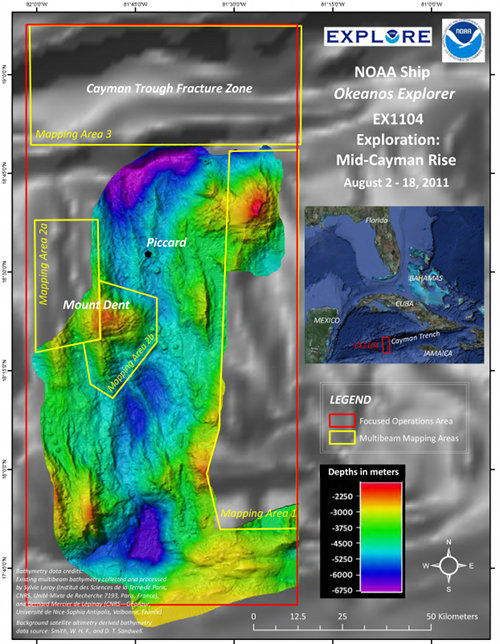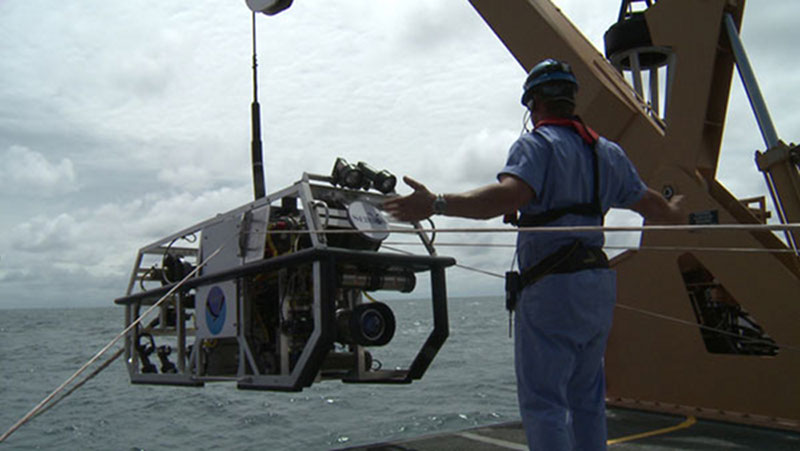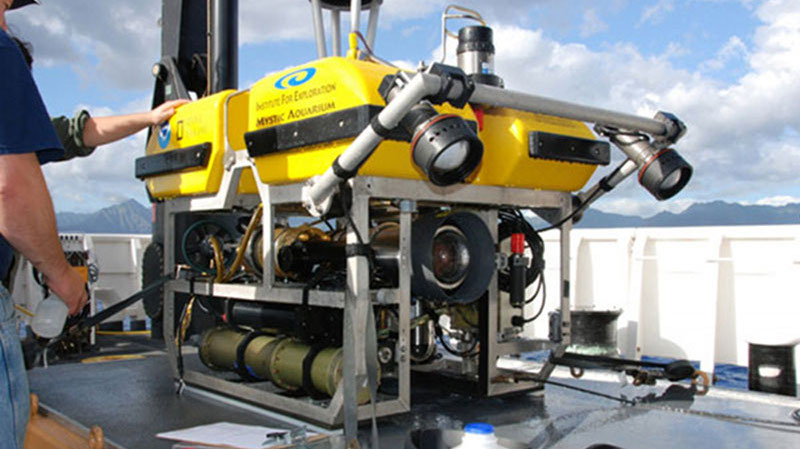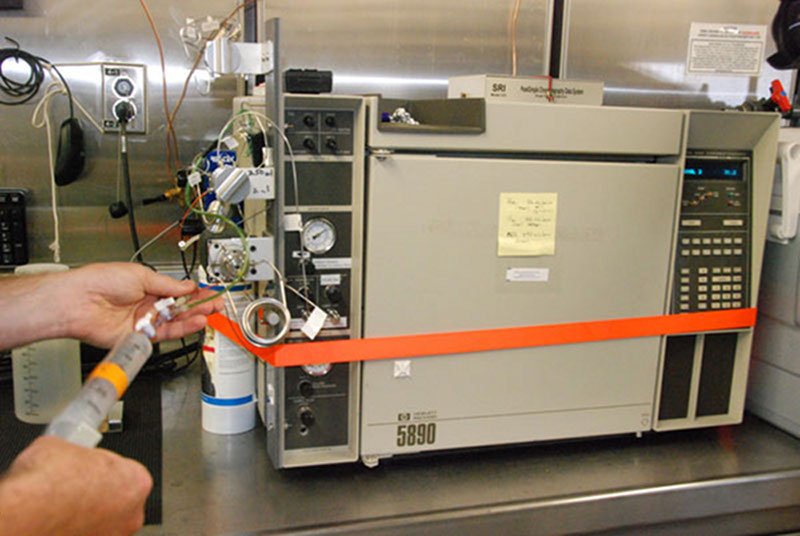
By Chris German, Science Team Lead/Senior Scientist - Woods Hole Oceanographic Institution
and Kelley Elliott, Expedition Coordinator - NOAA Office of Ocean Exploration and Research
Discovery of the first deep-sea vents and their associated biological communities on the Galápagos Rift in 1977 (Corliss et al., 1979) represented one of the major scientific breakthroughs of the past century and revolutionized our understanding of Earth, ocean and life sciences. Since then, more than 100 different vent sites have been found, worldwide, in different ocean basins and everywhere scientists have looked, new species have been found. Most recently, scientists have been surprised to find that the rocks that make up the seafloor at the least volcanically active mid-ocean ridges affect the chemistry of the resulting vent-fluids such that they are uniquely relevant to studying the origins of life – on Earth and beyond. This cruise to the Mid-Cayman Rise (one of Earth’s deepest and slowest spreading ridges) is following hot on the heels of the latest data suggesting there are multiple vent-sites present in a range of shallow and deep settings (German et al., 2010). This expedition will focus on the shallow outer “walls” of the ridge – previously thought the least exciting prospect for vent exploration – using seafloor mapping, water column investigations for tell-tale chemical signals of nearby venting, and detailed ROV observations. We expect major breakthroughs in our understanding of the geology and biology of the deep Mid-Cayman Rise seafloor, including some brand new deep-sea hydrothermal vents and the animals they host.

Map showing the operating area for the 2011 Mid-Cayman Rise Exploration. This expedition will focus on the shallow outer “walls” of the ridge – using seafloor mapping, water column investigations for tell-tale chemical signals of nearby venting, and detailed ROV observations. Image courtesy of NOAA Okeanos Explorer Program, MCR Expedition 2011. Download larger version (jpg, 3.6 MB).
Much of the August 2011 exploration will focus along the walls that bound either side of the Mid-Cayman Rise rift-valley where, long-lived fault-systems lift rocks from deep within Earth’s interior up to the ocean floor along so-called “oceanic core complexes”. Any hydrothermal activity we can find hosted in these rocks will be of particular interest because that would have the potential to host fluids with unique compositions that may be particularly relevant to “prebioitic chemistry” and, hence, future studies relevant to the origins of life and even deep space exploration in the decades to come. As well as exploring off-axis to the east and west of the Mid-Cayman Rise, we also expect to explore to the north where the ridge-axis is truncated by the deep east-west trending Cayman Trough fracture zone. At its deepest, the Cayman Trough extends to >6500m deep. But for this expedition we will be more interested in what rocks get exposed in the cliff face that rises up from the bottom of the trough because that will provide us with a unique opportunity to look at what typically lies beneath the seabed within the oceanic crust that covers roughly two-thirds of Earth’s surface.
NOAA Ship Okeanos Explorer will depart Balboa, Panama on August 2, 2011 and begin her transit to the Mid-Cayman Rise, tentatively arriving at our primary operating area on August 5th. Over the course of 10 days, 24-hour mapping, ROV and CTD rosette operations will be conducted to systematically explore the region using Okeanos Explorer’s core capabilities.
Using the ship’s deep-water multibeam sonar we will map in high resolution the oceanic core complexes composing the rift valley walls of the Mid-Cayman Rise, and the northern wall of the Cayman Trough Fracture zone. We will also explore the water column using a CTD rosette and an attached suite of in situ sensors, looking for evidence of hydrothermal activity. Water samples collected using the CTD rosette will be analyzed aboard the ship using a Gas Chromatograph to determine the concentrations of dissolved methane present. While high temperature vents emit a range of chemicals into the oceans that can be detected remotely using in situ sensors, only methane is enriched in all known forms of deep-sea hydrothermal systems and, hence, represents our measurement of choice for deep ocean exploration where we don’t know, in advance, what we expect to find. Without this capability, we might sail right past some vent-types without ever knowing they were there!

Image courtesy of NOAA Okeanos Explorer Program, MCR Expedition 2011. Download larger version (jpg, 1.1 MB).

Image courtesy of NOAA Okeanos Explorer Program, MCR Expedition 2011. Download larger version (jpg, 610 KB).
Targets of interest will be explored in detail using the Institute for Exploration’s (IFE) Little Hercules ROV (left) and NOAA’s newly developed Seirios camera sled (right)– a two-body ROV system equipped with high definition cameras and powerful lighting systems capable of diving to 4000m depth. When deployed, the ROV will be our “eye in the sea,” providing the expedition team and audiences on shore with a spectacular first look at the deep-sea habitats in the area.
The NOAA Ship Okeanos Explorer is one of the newest additions to the NOAA fleet and was commissioned in 2008. It provides accommodations for up to 46 crew and technicians. Unique to this ship is that most of the scientists will remain ashore. Through telepresence, live images from the seafloor and other science data will flow over satellite and high-speed Internet pathways to scientists standing watches in Exploration Command Centers (ECCs). During this expedition, an international team of scientists will work primarily from an ECC located at the University of Rhode Island and other remote locations. These scientists, and others on call if a discovery is made at sea, will add their expertise in real-time to at-sea operations.
Live video and embedded audio of expedition participants communicating about operations will be streamed to shore during the expedition and, for the first time, is expected to be available to the public on standard internet for the duration of an Okeanos Explorer expedition! The public can now “join” the expedition team in real-time as they explore the ocean and make discoveries from hundreds to thousands of meters below the ocean surface.

Water samples collected using the CTD rosette will be analyzed aboard the ship using a Gas Chromatograph to determine the concentrations of dissolved methane present. While high temperature vents emit a range of chemicals into the oceans that can be detected remotely using in situ sensors, only methane is enriched in all known forms of deep-sea hydrothermal systems and, hence, represents our measurement of choice for deep ocean exploration where we don’t know, in advance, what we expect to find. Image courtesy of NOAA Okeanos Explorer Program, MCR Expedition 2011. Download larger version (jpg, 1.2 MB).
This expedition provides unique and extensive opportunities to the public and students, bringing materials linked to this shared adventure into their classrooms and to their fingertips. Educational products related to the expedition include this website with essays, daily mission logs and imagery, near real-time ship tracking, educational modules and lesson plans on hydrothermal vents.
The history of Mid-Ocean Ridge investigations is one of sustained international collaboration and the 2011 Mid-Cayman Rise Exploration is no exception. This year, our program is being conducted in partnership with United Kingdom scientists, both on-shore and at sea, and is benefiting from recent cruises and data provided from the USA, UK, France and Japan in pursuit of our on-going exploration. Follow-on cruises aboard both UK and Japanese ships, using the Isis ROV and Shinkai 6500m submersible respectively, are also planned for Spring-Summer 2012.
Last summer, on its maiden voyage, the Okeanos Explorer employed its unique capabilities to initiate a 5-year ocean exploration partnership with Indonesia. The first year's results did not disappoint; Indonesia's deep seas are at least as biologically diverse as its vaunted island-based ecosystems. We continue that partnership this year as we explore the Galapagos Rift and Mid-Cayman Rise together.
This project builds upon, and is collaborative with, an on-going NASA ASTEP (Astrobiology Science and Technology for Exploring Planets) project that provided the first evidence that there were hydrothermal sites awaiting discovery on the Mid-Cayman Rise in 2009 (German et al., 2010). Likewise, we anticipate that this mission will also prove invaluable to a planned follow-on NSF program, currently scheduled for January 2012, that will focus on detailed sampling at and around as many as possible of the vent-sites that have been discovered by the end of this mission.
NOAA's partners in this expedition include the University of Rhode Island; Woods Hole Oceanographic Institution; University of Southampton; University of Wyoming; Duke University Marine Lab; Marine Biological Laboratory; Indonesia Ministry of Marine Affairs and Fisheries and the University of New Hampshire.